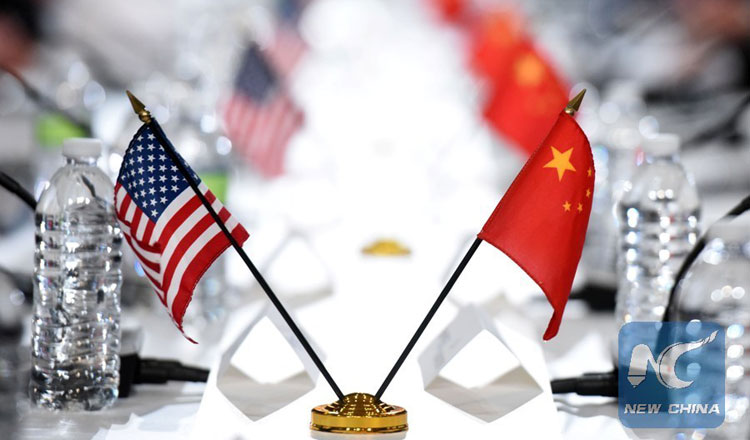COLUMN-OPINON: Asian identities and the US-China bifurcation of world order – Sim Vireak / Asia Times
With the growing bifurcation of world order through the increased rivalry between the US and China, there is a tendency that the term “Asia-Pacific” is being eliminated gradually, which is unfortunate in terms of Asian social construction, diverse cultural identities, and inclusive geographical definitions.
During Barack Obama’s administration, “pivot to Asia” was the mantra for the United States’ approach to the Asia-Pacific region considering the increased notations of concepts such as “the rise of Asia” and “the Asian Century.” The insinuation was that these phenomena were centered in the Asia-Pacific and were becoming China-centric, which was undesirable for the America’s dominance of the global order.
As the No 1 superpower, the US has reasons to worry about China’s rise, whether it is peaceful or is challenging the current world order in which the US is central. From the American point of view, China’s status is evolving gradually from “competitor” to “challenger” and maybe in the future to “rival” or even “enemy.”
The term “Indo-Pacific” was introduced as a strategic concept to challenge that evolution, not against the Asia-Pacific as a whole but against a China-centric Asia-Pacific. The “Indo-Pacific Strategy” was featured clearly in the 2017 US National Security Strategy. From that time on, the term “Asia-Pacific” seems to have gradually disappeared from the discourse of international relations for the region.
For Washington, the term “Indo-Pacific” made sense, especially in strategic and military terms, when the US started to expand its Pacific Command westward to cover the Indian Ocean region as its area of responsibility in 2018 by renaming it the Indo-Pacific Command. The Indo-Pacific Strategy was seen as a containment policy to compete against the increased popularity of China’s Belt and Road Initiative, and China’s rise itself.
Including “Indo-” in the term suggested that the US wanted to have India help contain China’s rise.
Countries in the Asia-Pacific region cannot outright deny the promotion of the Indo-Pacific Strategy, as they do not want to offend the US. Thus, for instance, countries in the Association of Southeast Asian Nations have walked a tightrope by introducing their own “ASEAN Outlook on the Indo-Pacific” (AOIP) in 2019.
While the term Indo-Pacific makes sense in a military-strategic context, it does not do justice to the millennia-old concept of “Asia” in terms of geography, cultural identities and social constructs that are inclusive and diverse.
There are Indian civilizations and Chinese civilization, but there are also many other civilizations, although smaller, in the Southeast Asian region. Even small nations like Cambodia can have cultural influence toward a much larger one such as China.
For instance, after the Chinese Three Kingdoms period, in the 6th century Buddhism became the motif of cultural interaction between China and the Funan Kingdom centered in what is now Cambodia. Especially during the reign of Emperor Liang Wudi, numerous prominent Funanese monks traveled to China to propagate Buddhist teachings at the request of the Chinese emperor.
.

The millennia-old word “Asia” is more neutral, inclusive and diverse, but when scholars are starting to use “Indo-Pacific” to describe the Asia-Pacific region, that suggests the rejection of their own cultural identities and social constructs because of the geopolitical power struggles in the region.
Asia does not belong to China or India alone. And all Asians, China and India included, should be proud of their own cultural diversities.
The growing usage of the term Indo-Pacific is because many states in the Asia-Pacific region fear offending the US, and such fear can mean that cultural and geographical identity can be sacrificed.
This is unfortunate even if it is only being used by scholars in the area of international relations.
Indeed, the US is not the only country that is feared; China is too. Despite strong economic benefits and trade relations, some states in Southeast Asia and powers in the Asia-Pacific region such as Japan, India and Australia are afraid of China’s rise too, especially in terms of its military assertiveness and geopolitical and economic dominance.
They fear that despite arguing that its rise is peaceful, China will someday adopt the concept that the late US president Teddy Roosevelt used to describe his foreign policy, namely “speak softly, and carry a big stick.”
Of course, China cannot simply reduce its economic and military power to earn trust and address fear from countries concerned. But so long as the growing bifurcation of world order is concerned, countries in the Asia-Pacific region wish to see stable relations between the two superpowers, China and the US, at the global level.
At the regional level, it is fair to say that they wish to see how China can address fear of China’s rise by countries in the Asia-Pacific region in a meaningful and constructive manner.
Whatever approaches taken by China and the US, they should not be seen as China’s defeat by the US or the US losing its hegemonic dominance of the global order. Unfortunately, this is an extremely difficult solution to find.
.

Sim Vireak
Strategic Advisor to the Asian Vision Institute (AVI)
(The article first appeared at Asia Times. The views expressed are his own and do not represent those of his affiliation.)
https://asiatimes.com/2021/03/asian-identities-and-the-us-china-bifurcation-of-world-order/










